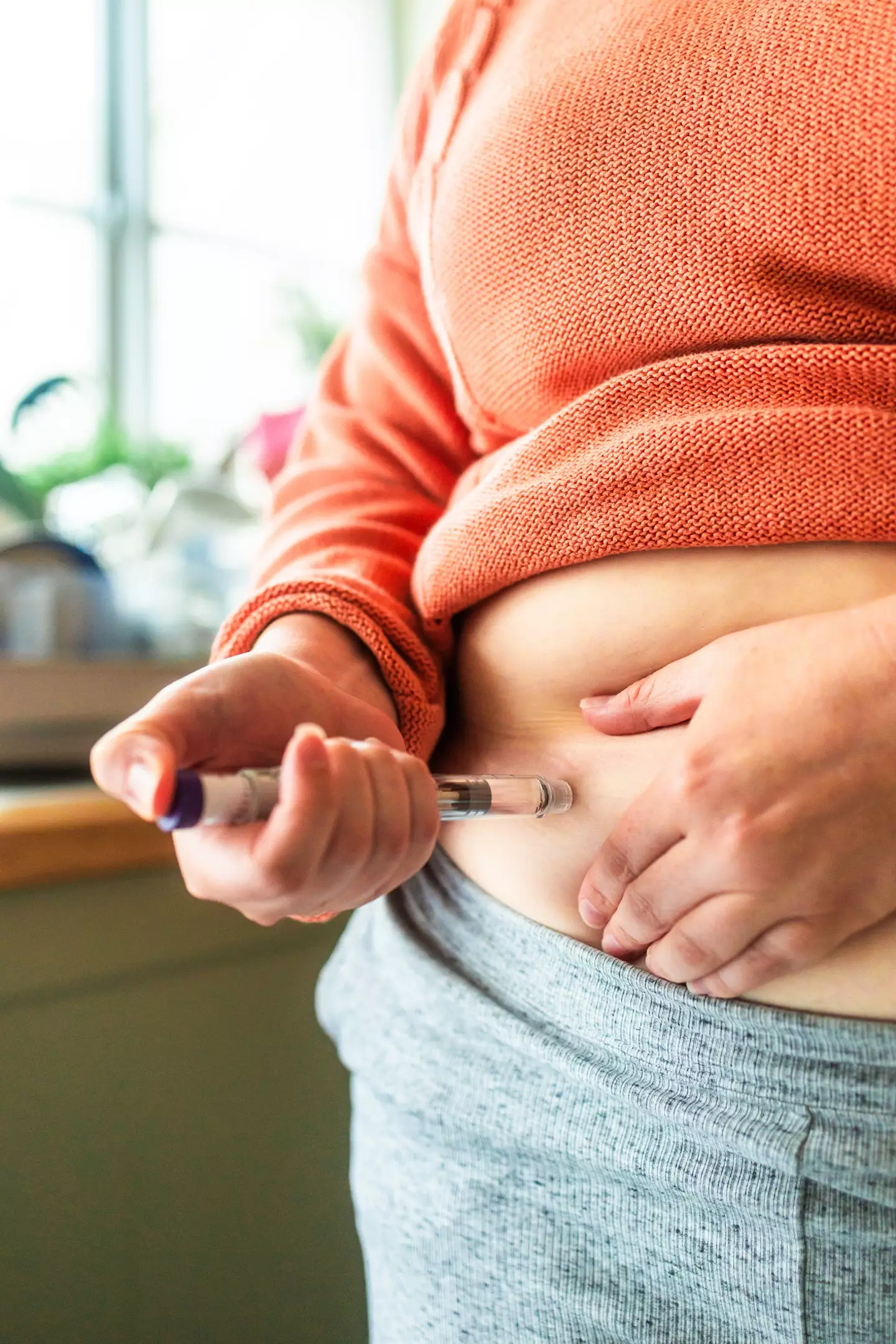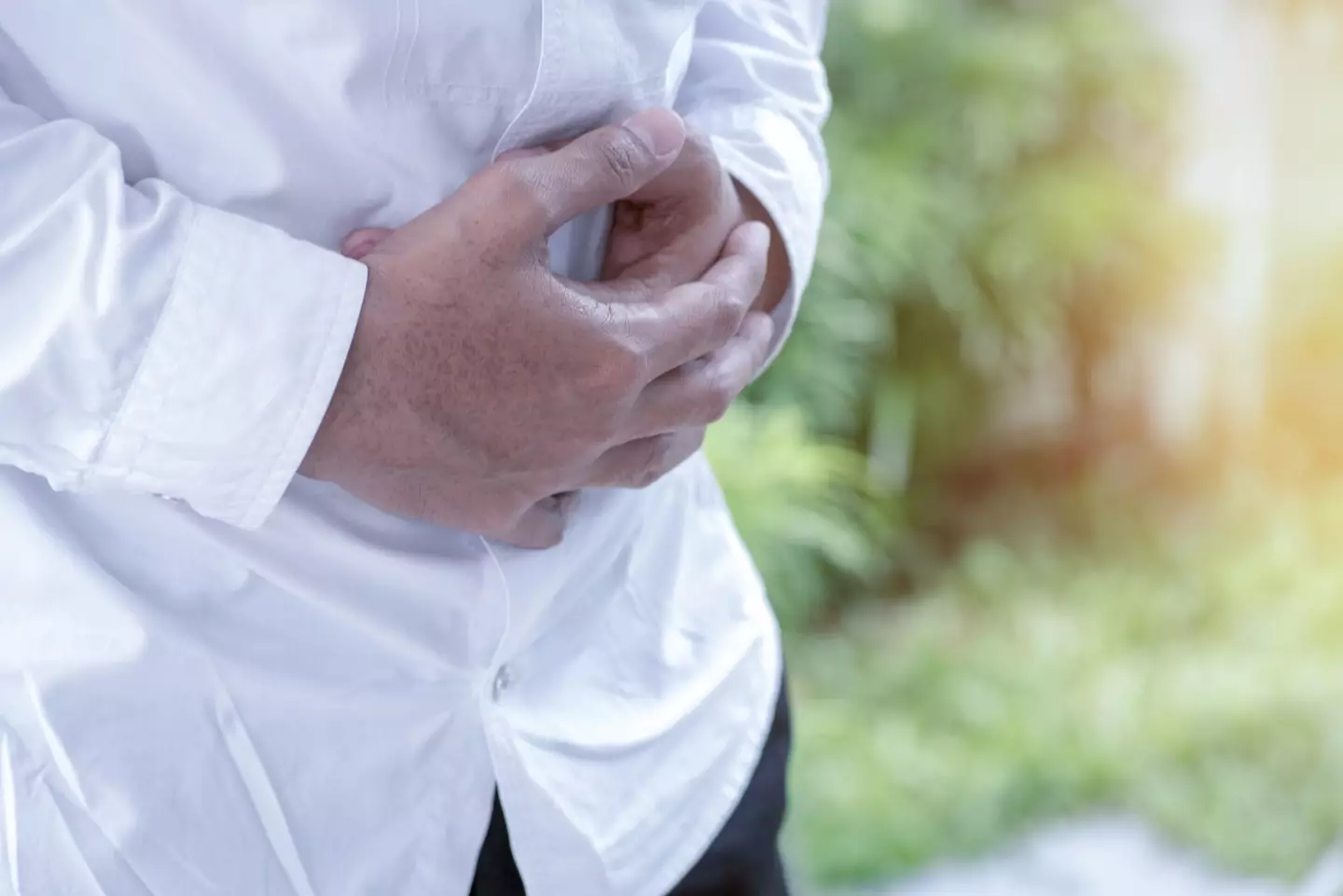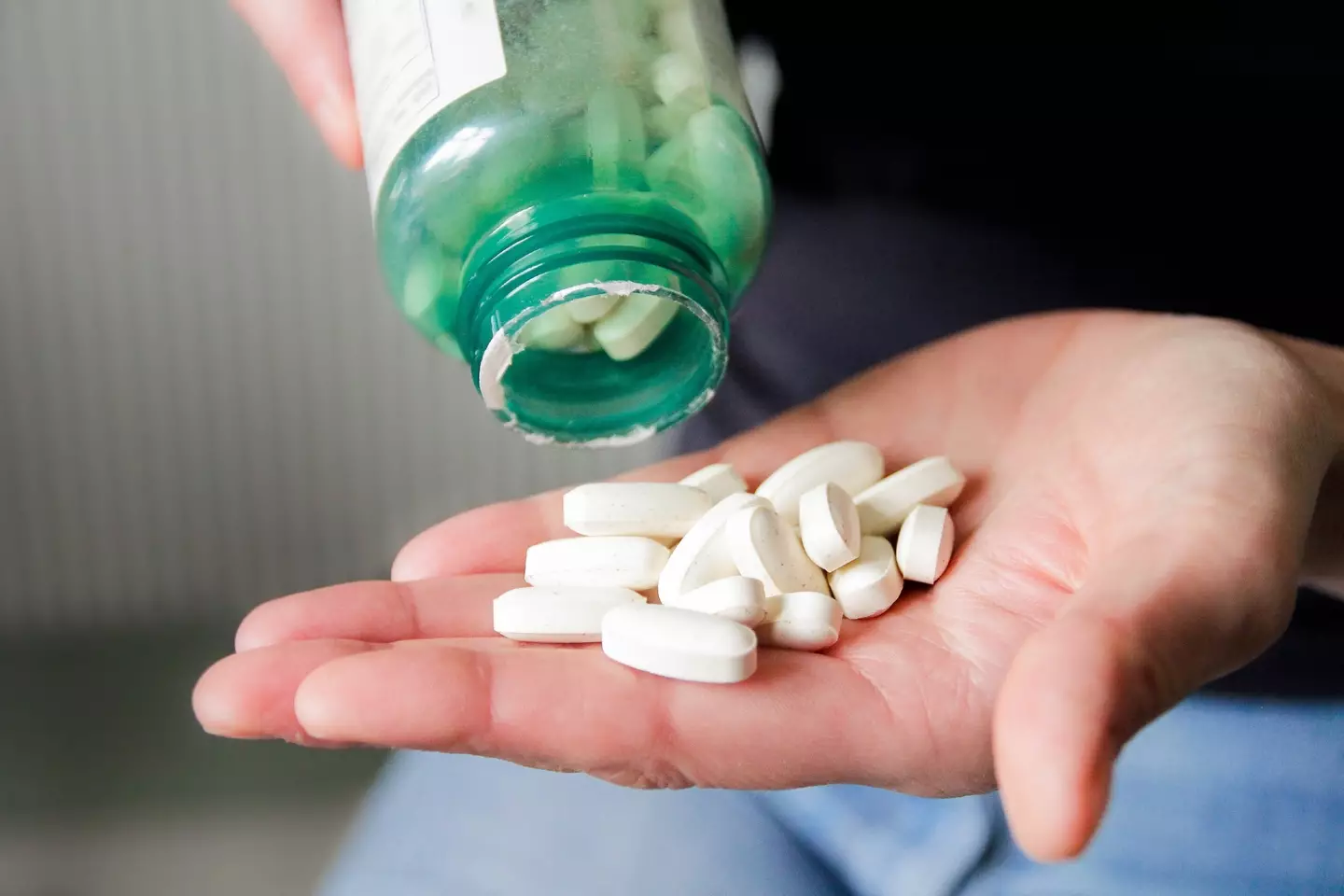Doctors have issued an urgent warning over the ‘golden dose’ hack for Mounjaro as it could be fatal.
According to a recent medical survey, around 12 percent of adults in the US use glucagon-like peptide 1 (GLP-1) drugs, which are designed to treat people with Type-2 diabetes.
Mounjaro is one of the many brands that work to lower blood sugar levels to treat diabetic people – but it has also been approved to treat obesity for its propensity in aiding weight loss.
However, reports suggest a rising number of Mounjaro users may be abusing the tool by squeezing extra doses out of the injector pens to get more bang for their buck, which medics are warning could be dangerous.
One injector pen comes pre-filled with a fixed dose that users take once a week, typically lasting for a period of four weeks.


An injector pen typically holds around four doses, but users are finding a way to extract a fifth ‘free’ one (Peter Dazeley via Getty Images)
Yet patients say a small amount of the drug remains in the pen at the end of the end of the round, with some reportedly promoting a new ‘hack’ to recover the liquid remnants.
Taking to social media, dozens have reportedly suggested a syringe and needle can draw out the dregs to create an additional ‘golden dose,’ as per The Daily Mail.
In the US, Mounjaro typically costs between $1,000 to $1,200 per month, according to Health System Tracker, so it’s clear to see why some customers are keen to lap up every last drop.
Given the pens cost a pretty penny, it is estimated users could save as much as $3,210 a year by concocting an extra fifth jab from each prescribed pen.
One user on Reddit wrote: “After the fourth dose [of Mounjaro], there is enough for a fifth. Over five months, you save yourself the cost of a pen. You extract the liquid [with a needle], shake off any excess to get air bubbles out, then inject.”
But drug specialists and doctors warn the trend poses some serious and potentially deadly risks.


The trend could be deadly (Getty Images)
Speaking to the news outlet, Professor Penny Ward, a pharmaceutical expert at King’s College London, said: “People are reading these tips on online forums and being tempted to use them to save money.
“But they’re risking serious side effects from overdosing by doing this — as well as the potential to develop a life-threatening infection. It’s not a good idea at all.”
The professor revealed the practice can be life-threatening ‘for several reasons,’ from infections to abscesses and overdosing.
She said: “These injections contain a slight overfill to ensure the full recommended dose is delivered each time. But by drawing this out with a separate syringe and using it as a so-called fifth dose, you’re exposing yourself to serious risk of infection.”
This is because the pens are ‘sterile’ when dispensed, but aren’t once they’ve been used.
“That means using leftover liquid to inject into the skin could introduce harmful bacteria,” Ward continued. “This can lead to an abscess — a painful build-up of pus — and if left untreated, potentially progress to sepsis, a life-threatening condition where the body’s organs begin to shut down.”


Acute pancreatitis requires hospital treatment (Getty Images)
As for overdosing, she explained patients will struggle to ‘measure the correct amount’ when creating their own syringe, meaning they could take more than intended and suffer gastrointestinal problems, like diarrhoea and vomiting, to ‘more serious complications’ like pancreatitis.
The NHS states acute pancreatitis can see people suffer intense pain in their abdomen, a high temperature and/or vomiting that requires hospital treatment.
“It can be terribly tempting, particularly if you’re paying for the drug privately, to try and save money,” Professor Ward continued. “But it’s just not worth the risks.”
UNILAD has contacted Eli Lilly, the manufacturer of Mounjaro, for comment.
Featured Image Credit: Getty Images/Peter Dazeley
Topics: Social Media, Health, US News, Fitness


A link has been discovered between cancer and an environmental crisis that President Donald Trump has previously labeled an ‘expensive hoax’.
We are, of course, talking about global warming, which the 78-year-old having described as ‘nonexistent’ and ‘mythical’ during his first term in office, with him even withdrawing the US from the Paris Agreement.
For those unaware, the Paris Agreement is an international treaty which sees countries pledge to tackle climate change, which UNILAD has previously explained.
On Trump’s first day back in the Oval Office for his second term in January, he signed an executive order titled ‘Putting America first in international environmental agreements’. The motion will see the US withdraw from the agreement, which will take effect later this year, on November 4.
But exactly how is climate change, which has been scientifically proven, linked to cancer?


President Donald Trump pictured in 2017 announcing his decision to pull the US out of the Paris Agreement (Win McNamee/Getty Images)
Researchers in Egypt analyzed the rates in which women in 17 Middle Eastern and North African countries have developed cervical, uterine, ovarian and breast cancers, comparing the figures to the rising temperatures.
Shockingly, they found that for every 1.8°F [1°C] that temperatures increased, up to 280 more cases were reported per 100,000 women.
Out of the four types of cancer, increases in ovarian cancer rose the sharpest – at 280 – while breast cancer increased the least – although it still recorded 173 more cases per 100,000 people.
“As temperatures rise, cancer mortality among women also rises – particularly for ovarian and breast cancers,” first author of the paper, Dr Wafa Abuelkheir Mataria of the American University in Cairo, told Frontiers.
“Although the increases per degree of temperature rise are modest, their cumulative public health impact is substantial.”


The study analyzing women in 17 Middle Eastern and North African countries detailed how breast, cervical, ovarian and uterine cancer was on the rise (Getty Stock Image)
Fatalities from the cancers almost double per each 1.8°F [1°C] temperature rise, from 171 deaths per 100,000 people, to 332.
The sharpest rise in mortalities was those with ovarian cancer – at 332 – with cervical cancer rising to 171 fatalities per 100,000 people.
Co-author Dr Sungsoo Chun, also of American University, theorised: “Temperature rise likely acts through multiple pathways. It increases exposure to known carcinogens, disrupts healthcare delivery, and may even influence biological processes at the cellular level.
“Together, these mechanisms could elevate cancer risk over time.”
As Chun mentioned, despite the observation, they have been unable to prove that climate change has caused the increase.


Flood debris covers Horseshoe Beach following the aftermath of torrential rain in New South Wales, Australia, last week – which was caused by climate change (Roni Bintang/Getty Images)
Instead, they believe that due to global warming, there has been an increase in carcinogens in the air due to wildfires and hurricanes – which occur more frequently due to climate change.
Due to these extreme weather events, the researchers believe that it could have a knock-on effect on women attending screenings and cancer treatment, which may cause an increase in deaths.
Chun added: “Women are physiologically more vulnerable to climate-related health risks, particularly during pregnancy.
“This is compounded by inequalities that limit access to healthcare. Marginalized women face a multiplied risk because they are more exposed to environmental hazards and less able to access early screening and treatment services.”
If you’ve been affected by any of these issues and want to speak to someone in confidence, contact the American Cancer Society on 1-800-227-2345 or via their live chat feature, available 24/7 every day of the year.
Featured Image Credit: Getty Images/Halfpoint Images
Topics: Cancer, Climate Change, Donald Trump, World News, Health


Experts have issued a warning about a common practice many will partake in every day that has been linked to deadly liver injuries in the US.
To put it simply, the liver plays a crucial role in the function of the human body and is responsible for assisting more than 500 activities, including filtering harmful substances from the blood.
Some livers metabolize toxins more slowly than others, meaning some drugs can overwhelm and cause harm to even the healthiest of livers out there.
But what about supplements? They’re something lots of us take everyday, thinking it’s good for our health and overall wellbeing.
Well, experts may say otherwise.


Liver damage can happen to the healthiest of people (Getty Stock Photo)
Medics are warning that herbal and dietary supplements could be causing liver damage, with a 2017 study finding 20 percent of liver toxicity cases nationwide are linked to herbal and dietary supplements.
Meanwhile, according to a 2022 study in the journal Liver Transplantation, from 1995 to 2020, supplement-related liver failure which put patients on the donor waiting list increased by eight times.
Robert Grafton was a regular taker of such supplements, but things changed when he reported dark urine and itching one weekend and recognised the symptoms of liver failure.
Grafton told NBC: “I stopped taking everything, thank goodness. If I hadn’t known, if I was not in the medical field, I might have thought, ‘Oh, I think I’m getting sick. I need to take some more of these supplements to help me feel better.’
“My liver enzymes were super elevated, my bilirubin was really high — all the signs of liver failure. I pretty much broke down, my wife as well. I was, at that point, thinking it was liver cancer, pancreatic cancer or something.”
After many sleepless nights, Grafton was told by doctors he had a ‘drug-induced liver injury’, which had been brought on by the supplements.
Dr. Dina Halegoua-De Marzio, who treated Grafton during his time of need, has since issued a warning about these supplements.


Experts have issued a waring about supplements (Getty Stock Photo)
“I think people assume these things are safe,” the health expert said. “The No. 1 reason we see people taking these are for good health or to supplement their health, and so I don’t think that they realize that there is a real risk here.”
It’s important to note the US Food and Drug Administration (FDA) does not monitor supplement safety before they are put on store shelves, so it’s important you know the risks.
In a statement provided to NBC News, the FDA warned: “Dietary supplements may contain ingredients that can have strong effects in the body, even if the ingredients are natural or plant-derived.
“Adverse events are more likely to occur if consumers take supplements in high doses, take multiple supplements or take supplements instead of or in addition to medications.”
Featured Image Credit: Getty Images/herstockart


The common causes of ‘summer penis’ have been revealed after a doctor issued a warning about the condition and detailed who is most at risk.
There’s no doubt a taboo still surrounds conditions down there, and to be honest, it really shouldn’t be like that.
In the US, for example, between 30 million and 50 million men have erectile dysfunction (ED), while according to NIH, the condition is more common in older men.
It happens when you can’t get or keep an erection during sex with studies and research finding the likes of stress or past trauma and physical problems contributing towards the medical condition.


The common causes of ‘summer penis’ have been detailed (Getty Stock Photo)
Intertwined with that is ‘summer penis’ – a simple biological reaction to the heat as blood vessels expand instinctively to help cool us down.
What is ‘summer penis’?
Medical experts have explained how as temperatures across many countries soar in the coming weeks, time spent in the bedroom may be less intimate than usual.
Doctor Donald Grant, a GP and senior clinical advisor at The Independent Pharmacy, told The Daily Mail that warm weather can pose ‘many health conditions’ and ‘exacerbate symptoms’ like erectile dysfunction (ED).
While ‘summer penis’ is not an official term, there are symptoms you can look out for.
GP Dr Chun Tang, from private healthcare clinic Pall Mall Medical explained that the penis can look larger, especially when flaccid.
And the presence of a ‘summer penis’ can also worsen ED symptoms for those who suffer.
Causes of ‘summer penis’
Some men are more likely to experience ED on hot days due to dehydration as your body uses ‘more water for homeostatic processes like sweating on hot days’, ED Clinics explains.
Increased blood pressure can also come about as a result of dehydration, which can make erections more difficult.
Basically, blood needs to be flowing within the body to the penis for an erection to happen, while narrowed blood vessels, also a symptom of dehydration, means the body is less likely to push this blood through.


‘Summer penis’ has some symptoms to look out for (Getty Stock Photo)
Dr Grant spoke further to the Daily Mail about how ED symptoms can worsen throughout the summer months, including that of how fatigue and tiredness can also cause issues.
“The warmer weather forces our bodies to work harder to maintain a safe internal temperature, which can often trigger fatigue,” the medical expert went on.
“Poor sleep can have a direct impact on hormone production, limiting the amount of testosterone produced, which, in turn, worsens ED symptoms and makes achieving an erection more difficult.”
Featured Image Credit: Getty Stock Image
Topics: Health


Scientists have issued a chilling warning about some US cities which are said to be ‘sinking’ as a result of global warming.
Climate change is a divisive topic, one that seems to create disagreements even at the top of government.
So, if the head honchos of the US are struggling to agree on the matter, then it doesn’t provide many answers surrounding climate change to the general public.
Experts in the field however are always a good source to listen to, with scientists now warning 34 million people in the US could be at risk.
A new study published in Nature Cities discussed this worrying trend, with the hope officials may take climate change more seriously.
“While often considered solely a coastal hazard due to the relative sea-level rise, subsidence also threatens inland urban areas, causing increased flood risks, structural damage and transportation disruptions,” the study states.
“We estimate that at least 20 percent of the urban area is sinking in all cities, mainly due to groundwater extraction, affecting ~34 million people. Additionally, more than 29,000 buildings are located in high and very high damage risk areas.”


Experts have issued a warning about New York (Getty Stock Photo)
It’s believed that cities such as New York, Dallas, and Seattle are all slowly falling into the Earth, as estimates illustrate that around 20 percent of urban land across the US is currently affected by alarming levels of subsidence.
After using satellite data to create high-resolution maps of land movement between the years of 2015 and 2021, experts came to some intriguing findings.
Houston showed the highest levels of ‘sinking’, while the likes of Las Vegas, New York and Washington DC all have high numbers.
Study author Leonard Ohenhen told Newsweek: “In drought-prone regions, reduced surface water availability may increase dependence on groundwater, accelerating aquifer depletion and land compaction.


Houston has showed the highest levels of ‘sinking’ (Getty Stock Photo)
“Additionally, in coastal cities, the combination of subsidence and rising seas leads to increased relative sea-level rise—meaning the land is sinking while the water is rising, compounding the hazard.
“This shortens the timeline for when cities reach critical thresholds for chronic flooding.”
The expert added: “When fluid is removed from the ground, particularly those composed of clay-rich or compressible sediments, the pore spaces collapse, leading to land compaction and surface subsidence.
“Houston, in particular, has experienced decades of aquifer drawdown. Subsidence is a silent but powerful force reshaping our cities.
“It’s a slow, often invisible process that undermines infrastructure, increases flood risk, and quietly erodes urban resilience.”



